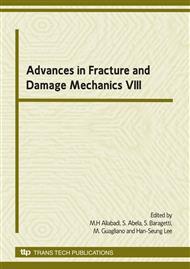[1]
Belytchko, T,. Lu, Y.Y., Gu, L., Element-free Galerkin methods, International Journal for Numerical Methods in Engineering, vol. 37, (1995\4), pp.229-256.
Google Scholar
[2]
Yagawa, G., Yamada, T., Free mesh method: A new mesh-less finite element method, Computational Mechanics, vol. 18, (1996), pp.383-386.
DOI: 10.1007/bf00376134
Google Scholar
[3]
Belytschko, T., Black, T., Elastic Crack Growth in Finite Elements with Minimal Remeshing, International Journal for Numerical Methods in Engineering, vol. 45 (1999), pp.601-620.
DOI: 10.1002/(sici)1097-0207(19990620)45:5<601::aid-nme598>3.0.co;2-s
Google Scholar
[4]
Fish, J., Markolefas, S., Guttal, R., Nayak, P., On adaptive multilevel superposition of finite element meshes, Applied Numerical Mathematics, vol. 14, (1994), pp.135-164.
DOI: 10.1016/0168-9274(94)90023-x
Google Scholar
[5]
Kikuchi, M., Wada, Y., Takahashi, M., Fatigue Crack Growth Simulation using S-FEM (in Japanese), Transactions of Japan Society of Mechanical Engineers, Series A, vol. 74 (2008), pp.812-818.
DOI: 10.1299/kikaia.74.812
Google Scholar
[6]
Kikuchi, M., Wada, Y., Takahashi, M., Li, Y., Fatigue Crack Growth Simulation Using S-Version FEM, Proc. ASME PVP2008, (CD-ROM).
Google Scholar
[7]
Sih, G.C., Strain-energy-density factor applied to mixed mode crack problems, International Journal of Fracture, vol. 10, No. 3, (1974), pp.305-321.
DOI: 10.1007/bf00035493
Google Scholar
[8]
Pook, L.P., The significance of mode I branch cracks for combined mode failure, Fracture and Fatigue: Elasto-Plasticity, Thin Sheet and Micromechanism Problems, (1980), pp.143-153.
DOI: 10.1016/b978-0-08-026161-4.50169-2
Google Scholar
[9]
Schollmann, M., Kullmer, G., Fulland, M., Richard, H. A., A New Criterion for 3D Crack Growth under Mixed-mode )I+II+III Loading,, Proceedings. Of the 6th International Conference on Biaxial/Multiaxial Fatigue and Fracture, vo. 2 (2001).
Google Scholar
[10]
Richard, H.A., Fulland, M., Sander, M. Theoretical crack path prediction, Fatigue and Fracture of Engineering Materials and Structures, Vol. 28 (2005), pp.3-12.
DOI: 10.1111/j.1460-2695.2004.00855.x
Google Scholar


